“Crossover” and “SUV” are terms that get put together a lot but they’re really two different things – or ought to be considered two different things.
But it’s easy to see them as being the same things.
Because crossovers look like SUVs – and that makes it easy to confuse them with SUVs.
The Ford Explorer has been both – which is really confusing!
So what’s the difference?
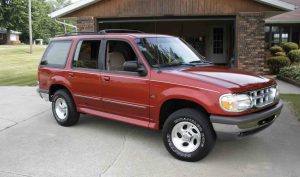
Crossovers are – generally – vehicles built on car underthings. As most cars are front-wheel-drive-based, so are most crossovers – with all-wheel-drive usallly available. They are usually more space efficient inside because less room is taken up under the floorpans by drivetrain parts – most of which are snugged up front (and sideways, or transversely mounted).
SUVs are – generally – built on rear-wheel-drive-based underthings, similar to the way trucks are put together. They usually offer four-wheel-drive, which differs from AWD in a number of ways (more below) and have their drivetrains mounted front-to-back. This takes up more room under the floorpans, but the payoff is a more balanced distribution of the drivetrain’s weight over the length of the vehicle as well as an intangible feel that many prefer.
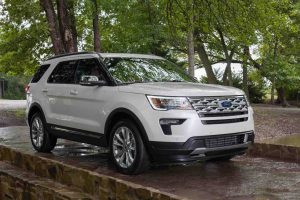
SUVs are also – usually – built more ruggedly and for that reason are more capable of towing heavier loads and better-able to handle severe conditions, such as off-roading.
The Explorer started out as an SUV – and became a crossover.
Now it’s an SUV, again.
What It Is
The Explorer – the new one – is a mid-sized/three-row SUV, available in rear-drive and 4WD configurations. It offers a choice of either a turbocharged four cylinder engine or a turbocharged V6 engine, both engines mounted front to back (longitudinally) rather than side to side, or transversely (as in most crossovers).
There is also a hybrid version, which pairs a different (larger) V6 with a battery pack/electric motor combination to deliver more power and better gas mileage than the non-hybrid, turbocharged four cylinder version.
There are also lot of trims to consider. Ten of them, if you count all the possibilities.
Prices start at $33,100 for the base trim, which comes with a 2.3 liter turbocharged four cylinder engine paired with a ten speed automatic and rear-wheel-drive. You can add “intelligent” four-wheel-drive as a stand-alone option. So equipped, the MSRP is $35,100.
There are also XLT, ST-Line, Limited, Timberline, King Ranch and Platinum trims – the latter topping out the range at $54,115.
This Ford is neatly positioned as the only SUV in this class – this size – with three rows, standard.
Similar-in-size models like the Kia Telluride/Hyundai Palisade, GMC Acadia, Honda Pilot and Mazda CX-9 – are all car-based crossovers. If you go up a size, there are SUVs to consider such as the Jeep Grand Cherokee L – which offers some things the Explorer doesn’t – like a V8 engine option and 4WD Low range gearing – but it’s a significantly bigger vehicle with a significantly higher base price ($36,995 to start).
There’s also the Toyota 4Runner, which offers a third row. But if you like this one you’d better hurry as it’s about to be redesigned after about 12 years on the market largely unchanged.
What’s New
The ST-Line is a new-for-2022 trim that gets you the look of the ST – including gloss black interior and exterior trim and a 20 inch wheel/tire package – without the higher-performance turbocharged 3.0 V6 engine and firmer-riding suspension calibrations that come standard with the ST. 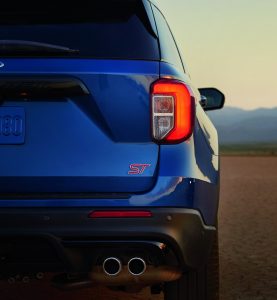
What’s Good
Real SUV capability in a class full of crossovers that haven’t got it.
Standard third row seating.
Multiple engines/driveline combos to choose from.
What’s Not So Good
Optional 4WD does not offer Low range gearing – limiting off-road capability.
No V8 engine option.
Optional V6 (and V6 hybrid) are only available in higher, much pricier trims.
The Explorer’s standard engine is a 2.3 liter turbocharged four that develops 300 horsepower and 310 ft.-lbs. of torque. This engine is essentially a re-calibrated version of the 2.3 liter engine that’s standard in the Mustang, where it makes a bit more rated horsepower (310) and a lot more torque (350 ft.-lbs.) which is odd given the Explorer is a much heavier rig than a Mustang and could use that additional 40 ft.-lbs. of torque that comes standard in the Mustang.
A ten speed automatic is paired with this engine, the top three speeds (gears, really) being overdrive gears, to step-down engine speed the higher your road speed. Tenth gear is a really deep 0.63 ratio, which is part of the reason this 4,300-plus pound SUV can still manage 21 MPG in city driving and 28 on the highway.
The much lighter – and much more aerodynamic – Mustang with the same basic 2.3 engine rates 21 city, 29 highway. Probably because it comes standard with a six speed manual transmission with fewer overdrives – and which can’t be programmed for optimum shifting for maximum MPGs.
You can go rear-wheel-drive or four-wheel-drive, but the Explorer’s four wheel drive system lacks low range gearing,which makes it more like the all-wheel-drive systems in most crossovers. However, it’s still based on a rear-drive layout, which means that most of the time, most of the engine’s power is routed to the rear wheels; most AWD systems are based on FWD layout and most of the time, most of the engine’s power is routed to the front wheels.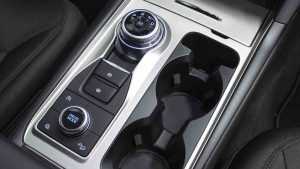
The FWD-based layout can be better in terms of providing more grip on wet/snow-covered payment on-road. But the rear-drive layout is better for pulling things. Hence the Explorer’s stout 5,300 lb. standard tow rating. Many crossovers in this class come standard with 3,500 lbs. of capacity – and none offer more than 5,000 pounds of available towing capacity.
If you buy an Explorer with the available 3.0 liter V6, the max tow rating goes up to 5,600 lbs. Power also goes up – to 400 horsepower and 415 ft.-lbs. of torque. So equipped, the Explorer massively outguns crossovers in this class like the Kia Telluride – which comes standard with a 3.8 liter, 291 horsepower V6 that’s less powerful than the Explorer’s standard 2.3 liter four cylinder engine.
The Telluride (and i’s Hyundai cousin, the Palisade) doesn’t offer an optional – stronger – engine.
Neither do the other crossovers in this class, such as the Mazda CX-9, which comes only with a 2.5 liter four cylinder engine and a 3,500 lb. maximum tow rating.
Interestingly, SUVs like the Jeep Grand Cherokee that offer V8 power aren’t as powerful as the V6-powered Explorer. The Jeep’s optional 5.7 liter V8 – which is almost twice as big as the Ford’s 3.0 V6 – only makes 360 horsepower and 390 ft.-lbs. of torque. However, the Jeep does offer Low range gearing with its 4WD system, which gives it the off-roading edge. It can also pulls more – up to 7,200 lbs – though the standard towing rating (3,500 lbs.) is lower than the Ford’s . . . as-it-comes.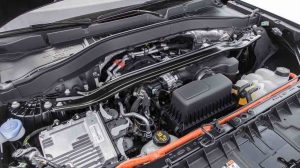
Toyota’s Taco is also a real-deal 4WD but it comes only with a 4.0 liter V6 and 270 horsepower.
The same ten speed automatic is standard with the Explorer’s optional V6 – as is the “intelligent” 4WD system, which has multiple terrain-modes that alter shift points and other driveline parameters to suit the selected driving conditions.
Timberline versions up the off-road ante with a standard limited slip rear axle and tow hooks rated to handle 150 percent of the vehicle’s curb weight, plus underbody skid plates and increased ground clearance via a one-inch lift, with complementary 18-inch Bridgestone Dueler all-terrain tires. 
There is one more possibility to consider – if you can afford to.
Ford also offers a 3.3 liter v6/hybrid powertrain – but only in the Limited and Platinum trims. The latter stickers for $50,280 to start for the rear-drive version. With the 4WD system that bumps to $52,280.
What do you get for what you pay? A bit more horsepower (318) than the base 2.3 liter four delivers and slightly better gas mileage, which upticks to 27 city, 28 highway.
The main problem with crossovers is they look – and feel – so much alike it’s hard to tell them apart.
Which makes the Explorer stand apart.
There’s a plantedness to it, which is to some degree a function of its heft (which is a function of its SUV-rather-than-crossover construction). It rides like other SUVs, which is hard to find in this size because the others in this class are crossovers.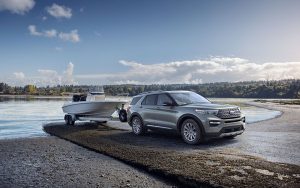
It also handles like an SUV – without the once-common handling weaknesses of SUVs. Most of the driveline’s weight is not over the front wheels – and because most of the power is kicked back to the rear wheels, most of the time, it feels more stable when accelerating and when cornering – italicized to emphasize that remarkable engineering achievement.
SUVs were once notorious for handling like the trucks most of them were based on, which is to say not very well. They tended to feel tipsy in the curves – and were prone to instability if subjected to sudden steering/braking inputs – a function of their higher center of gravity and more rigid suspension layouts, especially models with leaf springs and a “solid” (i.e., non-independent) axle in the rear. This got some people who bought first-generation SUVs – like the original Explorer of the ‘90s – and who drove them like cars – in trouble. That trouble, by the way, was probably why Ford turned the original Explorer into a more forgiving crossover.
But now, it’s back – as an SUV – without the less-forgiving handling attributes of old-school SUVs while reviving all the other attributes that make SUVs feel more secure and solid than crossovers.
Which is probably also why this thing can run up to almost 150 MPH – not “electronically limited.” That is a measure of Ford’s confidence in the Explorer’s stability at such speeds. Many SUVs are electronically limited to no more than 120 MPH.
This rig is also very quick getting up to speed – even with its standard four cylinder engine. Zero to 60 can be achieved in a scant 5.6 seconds. With the optional V6, that drops to just over five seconds. That’s as quick as a Corvette was in the ‘80s – and it’s about 2 seconds quicker to 60 than a Kia Telluride is. And a full second quicker than the V8-powered Cherokee L is, too.
The Explorer is a relatively compact SUV – for a mid-sized SUV.
It is 198.8 inches long overall, which is about as long overall as other three-row crossovers like the Telluride (196.9 inches long), Mazda CX-9 (199.4 inches long) and GMC Acadia (193.4 inches long).
It is not as long as the three-row Jeep Cherokee L (204.9 inches) which is an SUV. And yet the Ford has the roomier interior – with more cargo space: 18.2 cubic feet behind the third row; 87.8 total with the seats down vs. 17.2 cubic feet behind the Jeep’s third row and 84.6 cubic feet in total.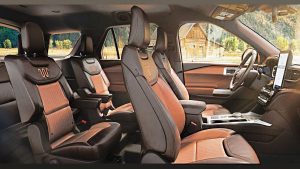
The Ford also has several inches more legroom up front (43 inches vs. 41.3 in the Jeep) and essentially the same legroom for second row passengers (39 vs. 39.4 inches) but without the extra inches – 6.1 – of length. This makes it an easier squeeze into and out of parking spots as well as tightens up the turning circle.
It’s also a less “teched-out” SUV.
It does not come standard with a digital dashboard – or a huge LCD flatscreen sprouting out of the center stack – though both are available (King Ranch) if you want ’em. This makes it more agreeable to people who want ’em – and them that don’t, too.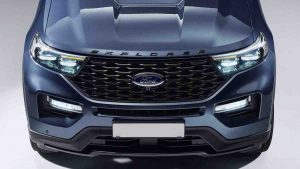
There is a rotary knob electric gear selector, which replaces the more tactile-feeling pull-it-back and into gear lever you used to find in SUVs. But – with a few lingering exceptions – all “shifters” are now sensors. There is no physical link between the thing in your hand and the transmission. It reads inputs – and makes selections.
The main downside of the rotary knob is that it’s awfully similar to the rotary knob for the terrain-select settings. Be careful not to select “Park” when you were looking for “Sport.” (Ford anticipated this issue, too. The transmission will not go into “Park” if you inadvertently select that range at 70 MPH.)
An upside to Explorer ownership is you’ll look like a cop – in the rearview mirror of the cars ahead of you. They will be eager to get out of your way. The effect is magnified if you buy a silver or white or dark gray Explorer – the ones favored for use as unmarked “cars” by traffic cops.
And yes, the third row is tight.
They are all tight – in SUVs this size. Including the next-size-up Cherokee L.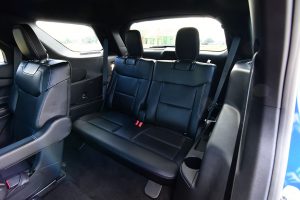
But they’re there.
To get adult-usable third row seating, it’s necessary to upsize to a full-size SUV.
Some neat little thoughtful design touches include a shelf just above the audio/climate controls for your phone. It’s placed just right and just the right size to keep your phone from flopping all over in the curves.
The Rest
The Explorer has two weak points. The first is the absence of Low range gearing – which limits its off-road capabilities relative to SUVs like the Jeep Cherokee. The Timberline’s additional clearance – up to 8.7 inches from the standard 7.9 – along with more favorable approach/departure angles for the bodywork – definitely help. But there’s simply not as much leverage without the gear-reduction of Low range gearing.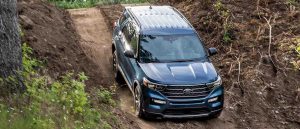
To put that into numbers, the first-generation Explorer had an effective Low range crawl ratio of 29.8:1 vs. the new Explorer’s 16.9:1 (in “Trail” mode).
That said, it probably won’t matter unless your plans include serious off-road work, where that kind of leverage can mean the difference between getting going and getting stuck.
The other issue may be longevity – of the Explorer’s breathed-on powerplants (hybrid excepted). The four and six make tremendous power relative to their displacement – and in relation to the power made by rivals’ engines of much larger displacement, such as the Jeep’s available V8.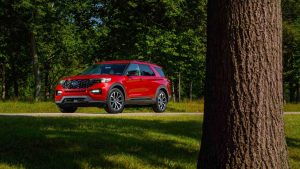
However, the V8 in the Jeep is not under pressure to make its power. It also has more internal surface area – bearing area, for instance – to absorb the pressure of combustion. There is more pressure on the smaller bearing surfaces of the Explorer’s 2.3 and 3.0 liter engines – plus more parts (the turbos).
They may be built tough enough to last 15-20 years, as most V8s will usually last before they show signs of becoming tired.
Only time will tell.
The Bottom Line
If you are interested in a three-row SUV rather than a crossover with three rows – and want it this size – this one may just fit.
. . .
Got a question about cars, bikes, or Sickness Psychosis? Click on the “ask Eric” link and send ’em in! Or email me at EPeters952@yahoo.com if the @!** “ask Eric” button doesn’t work!
If you like what you’ve found here please consider supporting EPautos.
We depend on you to keep the wheels turning!
Our donate button is here.
If you prefer not to use PayPal, our mailing address is:
EPautos
721 Hummingbird Lane SE
Copper Hill, VA 24079
PS: Get an EPautos magnet or sticker or coaster in return for a $20 or more one-time donation or a $10 or more monthly recurring donation. (Please be sure to tell us you want a magnet or sticker or coaster – and also, provide an address, so we know where to mail the thing!)
My eBook about car buying (new and used) is also available for your favorite price – free! Click here. If that fails, email me at EPeters952@yahoo.com and I will send you a copy directly!


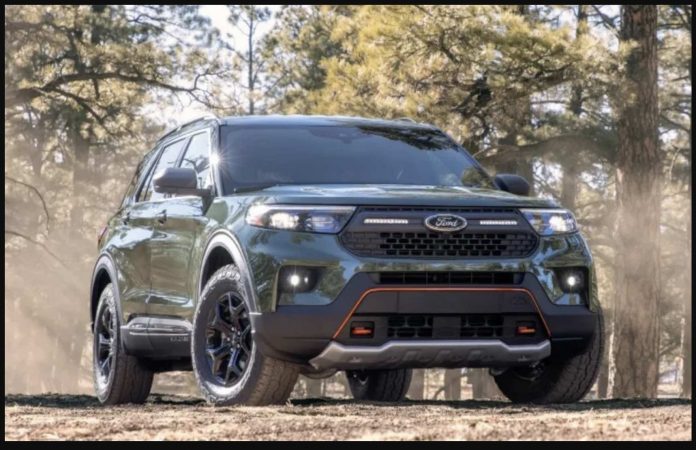

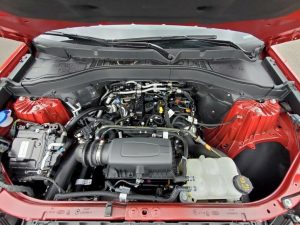
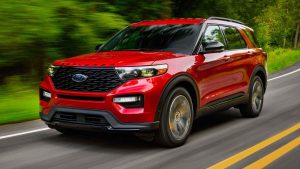








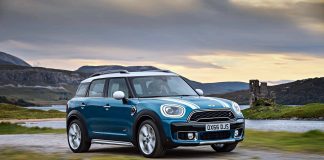
Since the police state has made the Ford Explorer their go to vehicle over the now extinct Ford Crown Victoria. There is no way I’ll ever consider one, since I don’t want to be associated with highwaymen.
The version of this to get is the Naturally Aspirated 3.3L V6. Fleet only though.
I used to drive a 92 Explorer. By the time I gave it up, it was 18-20 years old. I saw one with the same body style on the road yesterday and it made me so happy. Was a little jealous, I have to admit.
Eric, saw your article at American Spectator via Lew Rockwell. Concise and well done!
Thanks, Manse!
I’m hoping I don’t lose power; blizzard conditions today… I have a gennie but it’s too damned cold to deal with it. I’m going back to bed if the power cuts off!
You made no mention of the Toyota 4Runner, which is probably the only “real” SUV in this class segment. If one defines an SUV as truck-like then it’s the class definition being actual body on frame (not unibody), solid rear axle (not independent rear suspension) and still as of this year runs an old fashioned normally aspirated V6 and proper two-speed transfer case, which even still has a lever.
Something I noticed as well.
I don’t think it is just Eric, it seems when truck and SUV reviews are done, either written or you tube, it seems the elephant in the room cannot be spoken about. One must compare to the other lesser offerings in the market and not the one that shames it. Reliability, resell value, and um, a real 4WD, nope, don’t mention it.
Though there was mention of a Taco, but its old info, 3.5 liter Atkinson engines post 2016.
I got 197k from my 97 Wrangler. The 2012 Jeep GC I replaced it with had the computer controlled “soccer mom” 4WD and was pretty worthless. The 2018 4Runner TRD ORP I currently drive is a joy!
I installed a 2.5 inch lift, dual batteries, added a additional fuse box from a 2004 Jeep GC to handle secondary power distribution (not a fan of Blue Sea). New front bumper is waiting to be installed when it gets warmer. (anything below 60deg is winter)
Aerodynamically it’s brick, but I didn’t buy it for speed or gas mileage. Hopefully I can get 200k. I’m pretty sure Toyota’s 6th gen will not be well received in the circles I travel in, but who knows.
It’s possible Eric (or Toyota and the market) view 4Runner as a mainly competitor to Wrangler and Bronco. It makes more sense to push 4Runner into a less general purpose platform in view of regulations for MPG, emissions, crash testing because in the next few years the penalty (e.g. gas guzzler for one) for owning a true BOF view that can be used routinely on unimproved roads is going to become quite substantial and that will push sales down when the costs have to be passed down to the consumer.
With the discontinuation of Land Cruiser in the U.S. it appears Toyota is putting all their eggs in 4Runner as actual off-highway capable wagons. Surely the new 4Runner will be based on the TNGA-F, which all of Toyota’s true trucks except maybe 70-series Land Cruiser (which we never got here anyway) should end up on. The global 300 series and Tundra are supposedly already on it.
So perhaps the Highlander will continue to grow or Sequoia gets shoehorned down to be a competitor to Explorer, Grand Cherokee, etc. It’s a still a slightly smaller and lighter duty vehicle but no reason the next generation couldn’t be beefed up.
I wonder if the transfer case has a 4-low gear but they didn’t make it avilable to the driver? Seems like it would be better to use a generic drivetrain over a unique part.